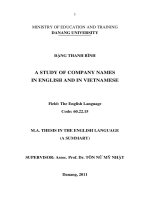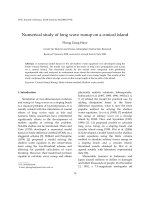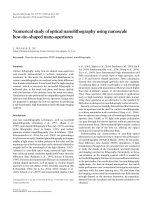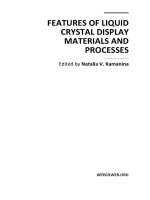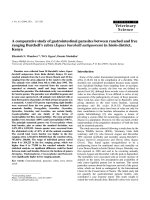Numerical study of liquid lubricated two layer and multiple layer herringbone grooved journal bearings
Bạn đang xem bản rút gọn của tài liệu. Xem và tải ngay bản đầy đủ của tài liệu tại đây (4.67 MB, 138 trang )
NUMERCIAL STUDY OF LIQUID-LUBRICATED
TWO-LAYER AND MULTIPLE-LAYER HERRINGBONE
GROOVED JOURNA L BEARINGS
LIU YAOGU
NATIONAL UNIVERSITY OF SINGAPORE
2003
NUMERCIAL STUDY OF LIQUID-LUBRICATED
TWO-LAYER AND MULTIPLE-LAYER HERRINGBONE
GROOVED JOURNA L BEARINGS
LIU YAOGU
(B.Eng, M.Eng, Xi’an Jiaotong University)
A THESIS SUBMITTED
FOR THE DEGREE OF MASTER OF ENGINEERING
DEPARTMENT OF MECHANICAL ENGINEERING
NATIONAL UNIVERSITY OF SINGAPORE
2003
Acknowledgements
I would like to express my deepest gratitude to my supervisors A/Prof. T.S; and A/Prof.
S. H. Winoto, for their invaluable help and guidance, their understanding and
encouragement throughout the completion of this thesis.
I would also like to thank the National University of Singapore for the research
scholarship, which makes this project possible. I also want to express my thanks to the
staff of the Fluid Mechanics Laboratory, the Computer Center and the Library of NUS,
for their significant assistances and their excellent services.
I would also like to express my appreciations to my friends for their help, especially to
Miss Wan Junmei and Mister Liao Wei for their unserved advices at the beginning of
this project.
The support and encouragement from my wife will always be remembered and
appreciated. During my study in National University of Singapore — for two years —
she brought up our son by herself in China. It is really not easy for her. I hope I can
give my family a good life after my graduation.
i
Table of Contents
Acknowledgements
i
Table of Contents
ii
Summary
vi
Nomenclature
viii
List of Figures
xi
List of Tables
xv
Chapter 1
1.1
Introduction
1
Background
1
1.2 Literature review
5
1.3
1.2.1
Jakobsson-Floberg-Olsson cavitation theory
5
1.2.2
The cavitation models
6
1.2.3
Studies on two-layer HGJBs without considering the cavitation
8
1.2.4
Studies on two-layer HGJBs considering the cavitation
11
1.2.5
Studies on multiple-layer HGJBs
12
Objective and Scope
Chapter 2
Numerical Studies on Two-layer Herringbone Grooved
Journal Bearings – Symmetrical Groove Patterns
2.1
12
Analytical model and numerical method
14
14
ii
Table of Contents
2.1.1
Governing equation for the journal bearings considering the cavitation 14
2.1.2
Coordinate transformation
18
2.1.2.1 General coordinate transformation
18
2.1.2.2 Treatment at the groove apex point
19
2.1.3
Lubricant film thickness of the HGJBs
19
2.1.4
Numerical method
21
2.1.5 Boundary conditions and convergence criteria
22
2.1.6
23
Load capacity and attitude angle
2.2
Validation of the computational program
24
2.3
Grid dependent study for the two-layer HGJBs
25
2.4
Studies of the pumping effect of herringbone grooves
25
2.4.1
The stability analysis of HGJBs and plain journal bearings
26
2.4.2
The pressure and cavitation distribution of HGJBs and
plain journal bearings
28
2.4.2.1
Pressure distribution at small eccentricity ratio
28
2.4.2.2
Pressure and cavitation distribution at medial and
large eccentricity ratio
2.5
29
2.4.3 The load capacity analysis of HGJBs and plain journal bearings
30
Concluding remarks
31
Chapter 3
Numerical Studies on Two-layer Herringbone Grooved
Journal Bearings – Asymmetrical Groove Patterns
33
iii
Table of Contents
3.1
Introduction: asymmetrical HGJBs
33
3.2
Numerical method and boundary conditions
34
3.3 Results and discussion
3.3.1 Effect of groove-length ratio on asymmetrical two-layer HGJBs
3.3.1.1
35
35
The pressure and cavitation distribution due to the
groove-length ratio
35
3.3.1.2 The load capacity and attitude angle due to the
groove-length ratio
3.3.1.3 Disscusions
3.3.2 Effect of groove-depth ratio on asymmetrical HGJBs
3.3.2.1
37
37
38
The pressure and cavitation distribution due to the
groove-depth ratio
38
3.3.2.2 The load capacity and attitude angle due to the
groove-depth ratio
3.3.2.3 Discussion
3.4 Concluding remarks
Chapter 4
39
40
41
Numerical Studies on Multiple-layer Herringbone
Grooved Journal Bearings
43
4.1
Introduction: multiple-layer HGJBs
43
4.2
Numerical method and boundary conditions
45
4.3 Validations and discussions
46
iv
Table of Contents
4.4 Results and discussions
4.4.1
Numerical studies of reversible HGJBs
47
4.4.2
Numerical studies of four-layer HGJBs
50
4.4.2.1
Grid dependent study for the four-layer HGJBs
4.4.2.2
4.4.2.3
51
Effect of length-to-diameter ratio (L/D) on the
performance of four-layer HGJBs
Concluding remarks
Chapter 5
50
Effect of groove-length ratio and eccentricity on
cavitation and pressure distribution
4.4.2.4
50
Effect of groove-length ratio on load capacity and
attitude angle
4.5
47
Conclusions and Recommendations
53
55
57
5.1 Conclusions
57
5.2
60
Recommendations
References
62
Figures
68
Tables
118
v
Summary
In this research, the performance of the liquid-lubricated herringbone grooved journal
bearings (HGJBs) is investigated by using the modified Elrod’s cavitation algorithm.
By incorporating the JFO (Jacobsson-Floberg-Olsson, named after Jacobsson and
Floberg, 1957; Olsson, 1965) theory and the Elrod’s algorithm, the modified Reynolds
equation is used as the governing equation. Groove-shape-fitted grids are constructed
and a coordinate transformation method is used to capture all of the groove boundaries.
The modified Reynolds equation is transformed into the rectangular computational
region. The finite difference discretizing method is used to discrete the equation and
the Alternating Direction Implicit method (ADI method) is used to solve the equation.
Symmetrical and asymmetrical two-layer HGJBs and multiple-layer HGJBs (the
reversible and the four-layer HGJBs) are studied respectively.
In the case studies of the symmetrical two-layer HGJBs, the herringbone grooves’
pumping effect and its influence on journal bearing’s stability is studied and analyzed
carefully. It was found that, with the increase of the eccentricity ratio, the cavitation
may occur in the fluid film of the HGJBs, similar with the plain journal bearings.
However, at the same eccentricity, the cavitation of the HGJBs is much less when
compared with plain journal bearings. When working at high rotating speed and low or
non eccentricity, because of the herringbone grooves’ pumping effect, the HGJBs’
stability is much higher (free from the unstable condition: the half-frequency whirl),
vi
Summary
than that of the plain journal bearings.
For the asymmetrical two-layer HGJBs, the effect of the groove-length ratio and the
groove-depth ratio on the HGJBs’ performance is investigated. It is found that, for the
asymmetrical groove patterns, the pressure and cavitation distribution within the fluid
film of the journal bearing is asymmetrical too.
Lastly, for the multiple-layer HGJBs, the effect of the length-to-diameter ratio (L/D)
and the eccentricity is studied for different groove patterns. It was found that,
compared with the two-layer HGJBs, the multiple-layer HGJBs have significant
advantages. The reversible HGJBs can rotate in either direction and they are always
stable, regardless of the rotational direction. When the four-layer herringbone grooved
journal bearing is in operation, there will be two pressure peaks along the axial
direction of the journal bearing, which highly increases the journal bearing’s
self-centered ability. Thus, the four-layer HGJB’s reliability and stability is much
higher than that of the two-layer HGJB.
vii
Nomenclature
English symbols:
c
radial clearance
e
eccentricity
epsn
eccentricity ratio (ε )
g
switch function
h
film thickness
h
dimensionless film thickness ( h = h / c )
hg1,2
groove’s depth, the same as Hg1 and Hg2
Hg
groove’s depth, the same as hg (shown in Fig.2-2)
Hg1:Hg2 the groove-depth ratio for asymmetrical two-layer HGJBs (the same as hg1:hg2)
L
length of journal bearing (L=L1+L2+L3+L4)
L/D
length-to-diameter ratio (D=2R)
L1,2,3,4
groove leg’s length as shown in Fig.4-1
L1:L2
groove-length ratio for two-layer HGJBs
L1:L2:L3:L4 groove-length ratio for four-layer HGJBs
M
number of the total grid points in the x -direction
N
number of the total grid points in the z -direction
P
film pressure
P
dimensionless film pressure ( P = (P / ωµ)(c / R)2 )
PB
ambient pressure
viii
Nomenclature
PB
dimensionless ambient pressure
PC
cavitation pressure
PC
dimensionless cavitation pressure
R
bearing radius
t
time
t
dimensionless time ( t = ω ⋅ t )
U,U1, 2 journal surface velocity (ω ⋅ R )
wg
groove width
wr
ridge width
W
load capacity
W
dimensionless load capacity (W = (W / ωµR2 )(c / R)2 )
x
coordinate in circumference direction
x
dimensionless x, ( x = x / 2π R)
y
coordinate in fluid film thickness
z
coordinate in axial direction
z
dimensionless of z , ( z = z / L )
Greek symbols:
α
groove angle
β
bulk modulus
β
dimensionless bulk modulus: ( β = ( β / ωµ )(c / R)2 )
ε
eccentricity ratio (e / c)
ix
Nomenclature
ξ
coordinate axis in the transformed plane
η
coordinate axis in the transformed plane
θ
density ratio ( ρ ρ c )
µ
fluid viscosity
ρ
fluid density
ρc
fluid density at cavitation pressure
φ
attitude angle
ϕ
circumferential coordinate
ω
angular rotation speed
x
List of Figures
Fig.2-1
Journal bearing geometry and its nomenclature
68
Fig.2-2
Unwrapped geometry and some parameters of a HGJB
68
Fig.2-3
Groove-shape-fitted grids system for herringbone grooved journal
bearings
68
Nondimensional film thickness distribution along the circumference coordinate ( 2πx ) for a plain journal bearing and a herringbone
grooved journal bearing
69
Comparison of predicted pressure distribution and experimental
data for the plain journal bearing (Case 1, Table 2-1)
69
Comparison of nondimensional load capacity for HGJBs (Case 2,
Table 2-1)
70
Fig.2-7
Attitude angle of HGJBs and Plain-JBs due to eccentricity ratio
70
Fig.2-8
Load capacity of HGJBs and Plain-JBs due to eccentricity ratio
70
Fig.2-9
Comparison of the dimensionless pressure distribution between the
HGJBs and the plain journal bearings at small eccentricity ratios
71
Fig.2-4
Fig.2-5
Fig.2-6
Fig.2-10 Dimensionless pressure profile (along the middle line) due to the
eccentricity ratio (represented by ε or epsn) for HGJBs and PlainJBs respectively
74
Fig.2-11 Comparison of the dimensionless pressure (along the middle line)
between the HGJBs and Plain-JBs at different eccentricity ratio
75
Fig.2-12 Comparison of the dimensionless pressure distribution between the
HGJBs and the plain journal bearings at large eccentricity ratios
76
Fig.2-13 Cavitation ratio of HGJBs and Plain-JBs due to eccentricity ratio
79
Fig.2-14 Cavitation distribution for HGJBs and Plain-JBs respectively
79
Fig.3-1
Pressure distribution (along the grooves at 2πx = 0.9817 ) due to the
eccentricity ratio and the groove-length ratio (L1:L2)
80
xi
List of Figures
Fig.3-2
Dimensionless pressure distribution due to the groove-length ratio
(L1:L2) for HGJBs (Case 5 of Table 3-1) at ε =0.80
83
Cavitation distribution due to the groove-length ratio (L1:L2) for
HGJBs (Case 5 of Table 3-1) at ε =0.80
84
The load capacity and the attitude angle due to the groove-length
ratio and the eccentricity ratio (epsn)
85
Pressure distribution (along grooves at 2πx = 0.9817 for ε =0.80)
due to the groove-depth ratio
86
Dimensionless pressure distribution due to the groove-depth ratio
(hg1:hg2) for HGJBs (Case 6 of Table 3-1) at ε =0.80
88
Cavitation distribution due to the groove-depth ratio for HGJBs
(Case 6 of Table 3-1) at ε =0.80
89
Fig.3-8
The load capacity and the attitude angle due to the groove-depth ratio
90
Fig.4-1
Unwrapped geometry of reversible HGJBs and four-layer HGJBs
91
Fig.4-2
Comparison of dimensionless load capacity with Kawabata(1989)’s
data for reversible journal bearings
93
Reversible HGJBs’ load capacity due to different length-to-diameter
ratio (L/D)
93
Reversible HGJBs’ attitude angle due to different length-to-diameter
ratio (L/D)
94
Reversible HGJBs’ cavitation ratio due to different length-to-diameter
ratio (L/D)
94
Fig.3-3
Fig.3-4
Fig.3-5
Fig.3-6
Fig.3-7
Fig.4-3
Fig.4-4
Fig.4-5
Fig.4-6
Reversible HGJBs’ cavitation distribution due to different length-todiameter ratio (L/D) at PC =-1.0, PB =0.0, and ε=0.60
Fig.4-7
Reversible HGJBs’ cavitation distribution due to different length-todiameter ratio (L/D) at PC =-1.0, PB =0.0, and ε=0.80
Fig.4-8
95
95
Pressure distribution (along the groove in the convergent region) due
xii
List of Figures
Fig.4-9
to the eccentricity and the length-to-diameter ratio (L/D) for the reversible HGJBs
96
Pressure distribution along the groove at x=0.65625 and ε=0.80 in
the divergent region for the reversible HGJBs
98
Fig.4-10 Dimensionless load capacity due to groove-length ratio (L1:L2:L3:L4)
for L/D=1.0
99
Fig.4-11 Attitude angle due to groove-length ratio (L1:L2:L3:L4) for L/D=1.0
99
Fig.4-12 Cavitation ratio due to different groove-length ratio (L1:L2:L3:L4) for
four-layer HGJBs (L/D=1.0)
99
Fig.4-13 Cavitation distribution due to different groove-length ratio (L1:L2:L3:L4)
for symmetrical four-layer HGJBs at ε=0.60 and ε=0.80 and L/D=1.0 100
Fig.4-14 Cavitation distribution due to different groove-length ratio (L1:L2:L3:L4)
for asymmetrical four-layer HGJBs
101
Fig.4-15 Symmetrical four-layer HGJBs’ pressure distribution along the groove
(in the convergent region) for L/D=1.0
102
Fig.4-16 Symmetrical four-layer HGJBs’ pressure distribution (along the groove
in the divergent region) due to groove-length ratio (L1:L2:L3:L4) at =
0.65625 and ε=0.80 for L/D=1.0
103
Fig.4-17 Asymmetrical four-layer HGJBs’ pressure distribution (along the groove
in the convergent region) due to groove-length ratio (L1:L2:L3:L4) at x=
0.15625 and ε=0.80 for L/D=1.0
104
Fig.4-18 Asymmetrical four-layer HGJBs’ pressure distribution (along the groove
in the divergent region) due to groove-length ratio (L1:L2:L3:L4) at x=
0.65625 and ε=0.80 for L/D=1.0
104
Fig.4-19 Dimensionless load capacity and attitude angle due to length-to-diameter
ratio (L/D) for four-layer HGJBs (L1:L2:L3:L4=5:5:5:5)
105
Fig.4-20 Dimensionless load capacity and attitude angle due to length-to-diameter
ratio (L/D) for four-layer HGJBs (L1:L2:L3:L4=6:4:4:6)
106
Fig.4-21 Dimensionless load capacity and attitude angle due to length-to-diameter
ratio (L/D) for four-layer HGJBs (L1:L2:L3:L4=7:3:3:7)
107
xiii
List of Figures
Fig.4-22 Dimensionless load capacity and attitude angle due to length-to-diameter
ratio (L/D) for four-layer HGJBs (L1:L2:L3:L4=6:4:6:4)
108
Fig.4-23 Dimensionless load capacity and attitude angle due to length-to-diameter
ratio (L/D) for four-layer HGJBs (L1:L2:L3:L4=7:3:7:3)
109
Fig.4-24 Cavitation distribution due to length-to-diameter ratio for L1:L2:L3:L4=
5:5:5:5
110
Fig.4-25 Cavitation distribution due to length-to-diameter ratio for L1:L2:L3:L4=
6:4:4:6
110
Fig.4-26 Cavitation distribution due to length-to-diameter ratio for L1:L2:L3:L4=
7:3:3:7
111
Fig.4-27 Cavitation distribution due to length-to-diameter ratio for L1:L2:L3:L4=
6:4:6:4
112
Fig.4-28 Cavitation distribution due to length-to-diameter ratio for L1:L2:L3:L4=
7:3:7:3
112
Fig.4-29 Pressure distribution (along the groove in the convergent region) due to
length-to-diameter ratio at different eccentricity for HGJBs with L1:L2:
L3:L4=5:5:5:5
113
Fig.4-30 Pressure distribution (along the groove in the convergent region) due to
length-to-diameter ratio at ε=0.80 for four-layer HGJBs with different
groove patterns
115
Fig.4-31 Pressure distribution (along the groove in the divergent region) due to
length-to-diameter ratio at ε=0.80 for four-layer HGJBs with different
groove pattern (L1:L2:L3:L4)
116
xiv
List of Tables
Table 2-1
Geometrical dimension and operating conditions
118
Table 2-2
Geometrical and operating conditions of HGJBs
118
Table 2-3
Grid dependent study for the two-layer HGJBs
119
Table 3-1
Geometrical and operating conditions of HGJBs
119
Table 4-1
Geometrical and operating conditions of HGJBs
120
Table 4-2
Geometrical and operating conditions of multilayer-groove HGJBs
120
Table 4-3
Grid dependent study for the reversible HGJBs
121
Table 4-4
Grid dependent study for the four-layer HGJBs
121
xv
Chapter 1
Introduction
1.1 Background
For rotating machineries, especially those operating at high speed, dynamic instability is
one of the main problems. Factors that cause this kind of instability include the magnetic
pulls, aerodynamic forces on turbine or compressor blades, gear impacts and others. In
journal bearings, the lubricant films would originate the undesirable self-excited
vibration, known as “half-frequency whirl”, in which the shaft orbits around the center
of the bearing at a frequency approximately equal to half of the spinning or rotational
velocity of the shaft, or a little less (Fuller, 1984). This is one of the most serious forms
of instability encountered in journal bearing operation. Hagg (1946) showed that when
the “half-frequency whirl” occurs, the capacity of the bearing to support radial loads
falls to zero, which means that the pressure force (acting along to the line of centers, FR )
drops to zero. Thus, if the pressure force (normal to the line of centers, Fφ ) is not equal
to zero, the attitude angle φ will be equal to 90°.
Another problem which is often encountered in the application of hydrodynamic or
liquid lubricated journal bearings is the cavitation, which is the disruption of what would
otherwise be a continuous liquid film by the presence of a gas or vapor or both.
Operating under some conditions, for the liquid lubricated journal bearings, the
cavitation will occur in the fluid film when the pressure falls below atmospheric
1
Chapter 1
Introduction
pressure. According to Dowson and Taylor (1979), there are two types of cavitations: the
gaseous cavitation and vaporous cavitation. Even though both of them are caused by the
fall of pressure in the lubricant, the cause is different for each. For the gaseous cavitation,
there are mainly two reasons for its formation. Firstly, when the sub-ambient pressures
occur inside the lubricant, the gaseous cavitation will form because of the ventilation
from the surrounding atmosphere. Secondly, when the liquid pressure falls below the
saturation pressure, the gaseous cavitation will occur due to the emission of dissolved
gases from solution. The vaporous cavitation, on the other hand, will form if there is a
significant drop in pressure inside the lubricant leading to boiling of the lubricant at the
operating temperature. In fact, the cause of most cavitation damage for a plain journal
bearing is due to the lubricant vapor accumulates in the bubbles and their sudden
collapse In particular, bubble collapses against a solid surface leads to high stresses and
usually causes wear (Wilson, 1974).
Great efforts have been made to solve the problems of stability and cavitations in
bearings, especially the herringbone grooved journal bearings (HGJBs). For example,
some herringbone grooves are engraved either on the shaft or on the inner surface of the
sleeve of HGJBs to prevent the formation of cavitations. This is because, when the shaft
or the bearing rotates, because of the herringbone grooves’ pumping effect, the lubricant
is pumped into the journal bearing along the grooves, and the pressure will be built up
along the grooves. As a result, the lubricant’ pressure inside the journal bearing is much
greater than those in plain journal bearings and thus prevent the formation of the
2
Chapter 1
Introduction
cavitation inside the journal bearings’ fluid film. The herringbone grooves’ pumping
effect also increase the journal bearings’ stiffness and the dynamic stability against the
self-excited half frequency whirl at high speed operations (Hirs, 1965; Bootsma and
Tielemans, 1977). One application of HGJBs is for hard disk drivers (HDD) where strict
requirements must be satisfied: high spindle rotational speed, big track density and low
non-repeatable runout (NRRO). To satisfy these requirements, HDD designers use the
fluid dynamic bearing spindle motors to replace the traditional ball bearing spindle
motors. Compared with the traditional ball bearings, the HGJBs have considerably lower
noise level, relatively higher stiffness and better stability, even though they are used in
high rotational speed situation. The technique is very reliable, there will be almost zero
non-repeatable runout and low noise (Bouehard et al., 1987).
Study on HGJBs was probably started as early as 1965 by Hirs (1965) whose
experimental findings are still widely referred to by many researchers today. It is Elrod
(1981), however, who first developed a cavitation algorithm by incorporating the
Jacobsson-Floberg-Olsson (JFO, named after Jacobsson and Floberg, 1957; Olsson,
1965) theory into the Reynolds equation to analyze the journal bearings, especially for
the HGJBs. Vijayaraghavan and Keith (1990a) later proposed a modified version of the
model to predict the journal bearings’ cavitation. Such a modified model was recently
used by Jang and Chang (2000) used this algorithm to analyze the factors of cavitation
in hydrodynamic HGJBs and by Wan et al. (2002) to study the cavitation phenomenon in
liquid-lubricated asymmetrical herringbone grooved journal bearings. Most recently, Lee
3
Chapter 1
Introduction
et al. (2002a,b) analyzed the herringbone grooves’ pumping effect and investigated the
cavitation and pressure distribution; as well as the influence of the herringbone grooves
on the stability of HGJBs. The later is done for both symmetrical and asymmetrical
two-layer HGJBs.
Most researches in the literature are however focused on two-layer HGJBs, and only
limited work has been done on multiple-layer herringbone grooved journal bearings.
Kawabata (1989) has proposed a regular and reversible rotation type herringbone
grooved journal bearing. Besides investigating cavitation foot-prints in the two-layer
HGJBs, Wan et al. (2002) also presented some of the cavitation foot-prints for
multiple-layer HGJBs, which are based on a small cavitation pressure.
Compared with the two-layer HGJBs, the three-layer HGJBs (known as reversible
HGJBs) can rotate in either direction. In practical applications, this ability is very
important. It allows the HGJBs to be used in the required direction of rotation. The
ability to rotate in both directions means that the HGJBs are always stable because of the
herringbone groove’s pumping effect, regardless of the rotational direction.
The four-layer HGJBs can only rotate in one direction. However, by replacing the
two-layer HGJBs with the four-layer HGJBs, the journal bearings’ reliability and
stability become much better. This is because that, along the journal bearing’s axial
direction ( z -direction), there are two pressure peaks which will highly increase the
4
Chapter 1
Introduction
journal bearings’ self-centered ability even if it works at the high rotational speed and
low or zero eccentricity. Lee et al. (2002c) investigated the effect of the groove-length
ratio and the length-to-diameter ratio on the performance of multiple-layer HGJBs. Liu
et al. (2003) showed the visualization of cavitation footprints in the liquid-lubricated
two-layer and multiple-layer HGJBs. More details about those are presented in Chapter
3 and Chapter 4 in this thesis.
1.2 Literature review
1.2.1 Jakobsson-Floberg-Olsson cavitation theory
Jakobsson and Floberg (1957) and Olsson (1965) proposed a set of moving cavitation
boundary, which is now called as the JFO theory. According to this theory, the fluid film
in journal bearings can be divided into two zones: one with a complete film in which the
usual Reynolds equation applies, and the other one, which is caivtated, only a certain
fraction, θ , of the film gap is assumed to be occupied by the fluid. This occupied space
is presumed to consist of a multiplicity of liquid striations completely spanning the gap
between the stationary and moving surfaces. In this theory, the most important point is
that the fluid flows keep the mass continuity not only in the full-film zones, but also in
the cavitated zones and at the interfaces between the full-film zones and the cavitated
zones. Many case studies showed that, when this theory is applied to the numerical
simulation of the journal bearings, the predicted results match the experimental data
very well (Elrod and Adams, 1974; Elrod, 1981; Vijayaraghavan and Keith, 1990a and
1990b; Jang and Chang, 2000; Wan et al. 2002). Thus this theory is well known as one
5
Chapter 1
Introduction
of the best theories which account for the flow physics of a fluid film: the rupture and
the reformation.
1.2.2 The cavitation models
To avoid the detrimental effects of cavitation, it is very important to know when and
where cavitation occurs in journal bearings. Recently, many researchers have carried out
experimental and numerical studies of study the cavitation phenomenon, recently, some
experimental studies and numerical studies were carried out by many researchers. Gas
cavitation as well as vapor cavitation was observed by Jacobson and Hamrock (1983) by
using a high-speed camera in dynamically loaded journal bearings. Lee and Pejovic
(1996) found that gas cavitation bubbles can survive for a long time while vapor
cavitation bubbles dissolve and disappear in less than a millisecond. Two different shaft
surface materials were used to investigate the influence of surface tension on pressure
built up and cavitation. It was found that no conclusive difference in the size and form of
the vapor cavitation region was found for materials with different surface tension, but
the fine inner structure within the vapor cavitation region was very different from
different surfaces.
Elrod and Adams (1974) derived a generalized form of Reynolds’ differential equation
on the basis of JFO theory, in which the complexities of locating film rupture and
reformation boundaries are avoided as this scheme automatically predicts cavitation
regions and preserves mass continuity within all the fluid film for the liquid-lubricated
6
Chapter 1
Introduction
bearings. Several years later, Elrod (1981) modified the finite definite difference portion
of the scheme, and presented a much better cavitation algorithm: the so called Elrod’s
cavitation algorithm. In this computational scheme, by introducing the cavitation index,
a “universal” differential equation is obtained by introducing the cavitation index and
the equation can then be used for the whole fluid film of liquid lubricated journal
bearings, including the full-film regions, the cavitated regions and the interfaces
between them. This scheme automatically implements the JFO theory but with mass
conservation being preserved within the whole fluid film.
Vijayaraghavan and Keith (1989) proposed a modification to the Elrod algorithm by
introducing a type differencing procedure. This procedure automatically switches the
form of differencing (central or upwind) of the shear flow terms in the full film and the
cavitated regions as required by the physics of the problem. Since it does not lead
needing to resorted to trial and error, the modified scheme is deemed as an improvement
on Elrod’s algorithm. Vijayaraghavan and Keith (1990a) later extended the work of
Elrod (1981) and proved that an approximate factorization technique in conjunction with
Newton’s iteration method for time accurate solutions can apply to both the steady and
unsteady state conditions. The grid transformation and grid adaption techniques,
presented by Vijayaraghavan and Keith (1990b) was stated to be more suitable for more
complicated problems and for saving the computational efforts. An extension of
transonic flow computational concepts was further developed in the analysis of cavitated
bearings by Vijayaraghavan et al. (1991).
7
Chapter 1
Introduction
In Yu and Keith’s (1995) work, a boundary element method was applied to Elrod’s
universal differential equation. Two confluent interpolation polynomials are used to
simulate the rupture and reformation boundaries where the derivative of the fractional
film content is discontinuous. It could better capture the cavitation boundary and thus
considerably reduce the effects of the grid shape and density on the solution. Aligned,
misaligned journal bearing as well as tapered, barrel and hourglass journal bearings are
analyzed.
In 1997, Mistry et al. proposed another new theoretical model, which was used to
analyze the fluid film in the cavitation zone of a journal bearing. The fluid film rupture
is included using the JFO condition while the reformation condition was modified to
take account of the presence of a continuous sublayer of the lubricant film on the journal
surface. The fluid flow behavior was modeled considering surface tension and
centrifugal force. It was found that the thickness of the lubricant sublayer adhering to the
journal surface is an exponential function of the speed while the eccentricity ratio rather
than speed has a predominant effect on the width of the streamers in cavitation zone.
1.2.3 Studies on two-layer HGJBs without considering the cavitation
Recently, the herringbone grooved journal bearings (HGIBs) are regarded as the
excellent replacement of the ball bearings in the spindle motors of computer hard disk
drives (HDD). The research on HGJBs began very early. Hirs (1965) studied the load
8
